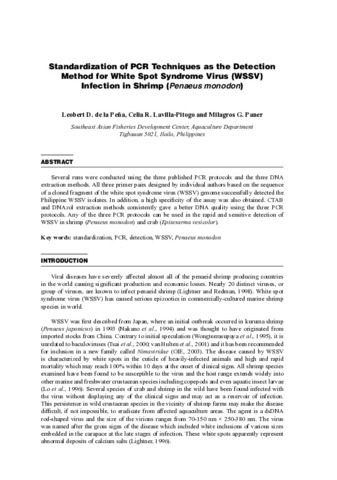Abdominal segment deformity syndrome (asds) and fused body segment deformity (fbsd) in cultured Penaeus indicus
- Global styles
- MLA
- Vancouver
- Elsevier - Harvard
- APA
- Help

View/
Date
2017Author
Page views
4,504ASFA keyword
AGROVOC keyword
Taxonomic term
Metadata
Perlihat publikasi penuh
Share
Abstract
The abdominal segment deformity disease (ASDD) is a new shrimp disease reported only in cultured Penaeus vannamei in Thailand. Shrimp with ASDD have deformed abdominal segment, jagged gut line and bumpy surfaces. Similar signs were observed in cultured P. indicus in the Philippines. However, aside from the signs described for ASDD, some P. indicus showing abdominal segment deformity syndrome (ASDS) had more severe deformities up to the extent that the number of body segments was reduced due to fusion. Shrimp with fused body segment deformity (FBSD) had four instead of five pairs of legs. To account the prevalence of the deformities in P. indicus, shrimp were classified into grossly normal shrimp (NS), shrimp with abdominal segment deformity syndrome (ASDS) and shrimp with fused segments (FBSD). Out of the shrimp sampled, 83.4 ± 5.4% was NS, 10.9 ± 6.2% was ASDS and 5.7 ± 3.0% was FBSD. Morphometric characteristics of the shrimp were measured. There was no significant difference in body weight (BW) among male and female NS, ASDS and FBSD. In both sexes, total length (TL) of FBSD was significantly shorter compared to NS and ASDS. Shrimp samples were also screened to be negative for known infectious viral diseases including white spot syndrome virus (WSSV), infectious hypodermal and haematopoietic necrosis virus (IHHNV), infectious myonecrosis virus (IMNV), P. vannamei nodavirus (PvNV), Macrobrachium rosenbergii nodavirus (MrNV) and Taura syndrome virus (TSV). Occurrence of ASDS and FBSD in post-larvae (PL) produced from captive and wild spawners were also determined. Based on a tank experiment, no significant difference was detected between the percentages of ASDS in PL produced from wild or captive spawners but FBSD was only noted in PL produced from the latter. Deformities generally did not affect the size of P. indicus except for the reduced length of shrimp with FBSD which when coupled with missing pleopods could lead to major economic loss for shrimp farmers if not addressed properly.
Suggested Citation
Santander-Avancena, S., Estepa, F. D., Catedral, D. M., Faisan, J. P., Jr., & de la Peña, L. D. (2017). Abdominal segment deformity syndrome (asds) and fused body segment deformity (fbsd) in cultured Penaeus indicus. Aquaculture , 466, 20-25. https://doi.org/10.1016/j.aquaculture.2016.09.036
Type
ArticleISSN
0044-8486Koleksi
- Journal Articles [1258]
Related items
Showing items related by title, author, creator and subject.
-
Sandfish (Holothuria scabra) as potential reservoir of white spot syndrome virus (WSSV) when co-cultured with black tiger prawn (Penaeus monodon)
de la Peña, Leobert D.; Caber, Dieyna B.; Villacastin, Anne Jinky B.; Cabillon, Nikko Alvin R.; Arboleda, Joey I.; Castellano, Jose Louis A.; Nava, Joseph Keith Paulo ; Watanabe, Satoshi (European Association of Fish Pathologists, 2024-03-08)
Since the first occurrence of White Spot Disease (WSD) in 1992, it is still listed as one of the crustacean diseases by the World Organisation for Animal Health in 2022. Horizontal transmission in co-culture systems is one ...
; Watanabe, Satoshi (European Association of Fish Pathologists, 2024-03-08)
Since the first occurrence of White Spot Disease (WSD) in 1992, it is still listed as one of the crustacean diseases by the World Organisation for Animal Health in 2022. Horizontal transmission in co-culture systems is one ... -
Standardization of PCR techniques as the detection method for white spot syndrome virus (WSSV) infection in shrimp (Penaeus monodon)
de la Peña, Leobert D.; Lavilla-Pitogo, Celia R.; Paner, Milagros G. (Aquaculture Department, Southeast Asian Fisheries Development Center, 2005-03)Several runs were conducted using the three published PCR protocols and the three DNA extraction methods. All three primer pairs designed by individual authors based on the sequence of a cloned fragment of the white spot ... -
White spot syndrome virus (WSSV) risk factors associated with shrimp farming practices in polyculture and monoculture farms in the Philippines
White spot sydrome virus (WSSV) is one of the most important viral disease of shrimp. Several studies to control the disease have been done. Tank experiments identified WSSV risk factors related to the physico chemical ...





